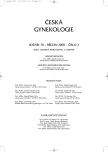Correlation of Urethral Mobility and Urethral Closure Pressure or Valsalva Leak-Point Pressure in Patients with Genuine Stress Incontinence
Authors:
A. Martan 1; J. Mašata 1; K. Švabík 1; P. Drahorádová 1; J. Hlásenská 2; M. Pavlikova 2
Authors‘ workplace:
Gynekologicko-porodnická klinika VFN a 1. LF UK, Praha, přednosta prof. MUDr. A. Martan, DrSc.
1; EuroMISE centrum UK a AVČR, Praha, ředitelka prof. RNDr. J. Zvárová, DrSc.
2
Published in:
Ceska Gynekol 2005; 70(2): 123-128
Category:
Original Article
Overview
Objective:
The aim of our study was to examine the relationship between urethral mobility in females and maximum urethral closure pressure (MUCP) at rest, and between urethral mobility and Valsalva leakpoint pressure (VLPP), and to determine whether urethral mobility correlates with MUCP and VLPP.
Design:
Cross-sectional clinical study
Settings:
Gynecological and Obstetric Clinic, First School of Medicine of Charles University and General Faculty Hospital, Prague.
Materials and Methods:
Fifty-two women with previously untreated GSI were recruited to participate in a clinical study. Their mean age was 57.2, mean body mass index (BMI) 28, and mean parity 1.8. As part of the urethral pressure profile we determined MUCP and functional urethral length (FUL). VLPP was assessed during US examination using an ultrasound contrast medium and color Doppler velocimetry (CDV). A perineal ultrasound examination in patients in supine position (by Acuson 128 XP 10, curved array probe 5 MHz) to assess the position of UVJ and the middle of the urethra was performed. The bladder was filled with 300 ml sterile saline.
Results:
We did not find statistically significant differences in the mobility of urethrovesical junction (UVJ) and middle of the urethra between patients with low or normal VLPP at 5% level. On the other hand, we found statistically significant correlation in the mobility of urethrovesical junction (UVJ) and middle of the urethra with MUCP, where these parameters were assessed as mutually dependent values. However, if we set the borderline of UVJ hypermobility at 50 degrees or more (the difference in the value of gamma angle at maximum Valsalva maneuvre and at rest), and a low MUCP at equal to or less than 30 cm H2O, then we do not observe any correlation between the values of urethral mobility and MUCP, since combinations of these two values are too extreme.
Conclusions:
This study mainly compares three parameters – the urethral mobility with MUCP and with VLPP. Based on our results we can conclude that there is no statistically significant correlation between hypermobility of the urethra and VLPP at 5% level. However, we did find a statistically significant correlation between MUCP and mobility of UVJ and middle of the urethra if the values for these parameters are not strictly assessed. If we set the borderline of UVJ hypermobility at 50 degrees or more and a low MUCP at equal to or less than 30 cm H2O, then we do not observe any correlation between the values of urethral mobility and MUCP.
Key words:
female urinary incontinence, urethral hypermobility, maximum urethral closure pressure, Valsalva leak-point pressure
Labels
Paediatric gynaecology Gynaecology and obstetrics Reproduction medicineArticle was published in
Czech Gynaecology

2005 Issue 2
Most read in this issue
- Coagulation Factor VIII in the Early Postpartum Period
- Abdominal Radical Trachelectomy – Technique and Experience
- Morgagni Cyst within Tubal Lipoma
- Giant Benign Mucinous Cystadenoma of Both Ovaries in Early Puerperium: Case Report and Review of Literature
